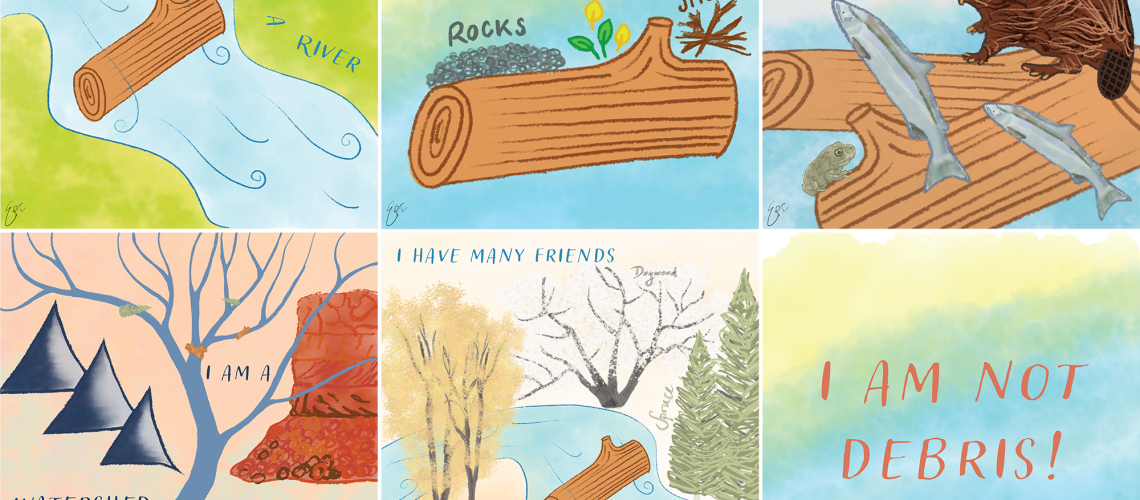Guest Post by Emily Iskin, 2022-2023 Sustainability Leadership Fellow, and Ph.D. Candidate in the Department of Geosciences at Colorado State University
Around the globe, rivers were once full of wood. Where did it go? And why does it matter that it’s gone? Wood was historically removed from rivers for transportation (think the Mississippi River), infrastructure, and safety, but we now know that the removal of wood can significantly alter river corridors.

Wood provides many benefits and performs many functions in river ecosystems. In relation to flows, wood stores water, sediment, and organic matter behind logjams1; acts as carbon storage2 (Fig. 1); and increases the exchange of water, gases, and nutrients between the stream and the streambed3–5 and between the stream and the floodplain6–8. Wood can create habitat for plants9–11 (Fig. 2) and animals12–14; and increase overall complexity and heterogeneity of the river corridor15–18. We also know that wood is stored for a period of time in streams, but that an essential function of wood is movement through river systems at varying rates19,20 to its final destinations of lakes and oceans21.

The fields of fluvial geomorphology, riparian ecology, stream biology, and river restoration have recognized the value of wood in rivers for decades. Barriers that need to be decreased or reversed for successful wood reintroduction include deforestation that reduces the historical source of wood, active removal of wood that naturally falls into rivers, fear of mobile wood damaging infrastructure such as bridges, and hesitancy around the local effects of wood in streams such as local flooding and backwater rise near logjams. Overcoming these barriers will require examples of successful reforestation near streams, a shift in policy and responsibility regarding where wood is put in and where it ends up, and eventual room for rivers to inundate their floodplains and move without restriction.
Restoration of natural sources of wood and reintroduction of wood to rivers is gaining traction with communities large and small, but success will require shifting the negative public perception22,23. This challenge can be overcome through increasing awareness and education around the benefits of wood in streams, starting with effective signs and displays in national and state parks and local river recreation sites. Shifting the view of what a natural stream looks like and increasing public acceptance of wood’s place in these systems is going to increase the speed of restoration and effectiveness of wood in streams. Without public support, the task of restoring wood to river systems is already dead in the water.
References
- Mao, L., Andreoli, A., Comiti, F. & Lenzi, M. A. Geomorphic effects of large wood jams on a sub-antarctic mountain stream. River Res Appl 24, 249–266 (2008).
- Beckman, N. D. & Wohl, E. Carbon storage in mountainous headwater streams: The role of old-growth forest and logjams. Water Resour Res 50, 2376–2393 (2014).
- Fanelli, R. M. & Lautz, L. K. Patterns of Water, Heat, and Solute Flux through Streambeds around Small Dams. Ground Water 46, 671–687 (2008).
- Lautz, L. K., Siegel, D. I. & Bauer, R. L. Impact of debris dams on hyporheic interaction along a semi-arid stream. Hydrol Process 20, 183–196 (2006).
- Sawyer, A. H., Bayani Cardenas, M. & Buttles, J. Hyporheic temperature dynamics and heat exchange near channel-spanning logs. Water Resour Res 48, (2012).
- Brummer, C. J., Abbe, T. B., Sampson, J. R. & Montgomery, D. R. Influence of vertical channel change associated with wood accumulations on delineating channel migration zones, Washington, USA. Geomorphology 80, 295–309 (2006).
- Sear, D. A., Millington, C. E., Kitts, D. R. & Jeffries, R. Logjam controls on channel:floodplain interactions in wooded catchments and their role in the formation of multi-channel patterns. Geomorphology 116, 305–319 (2010).
- Jeffries, R., Darby, S. E. & Sear, D. A. The influence of vegetation and organic debris on flood-plain sediment dynamics: case study of a low-order stream in the New Forest, England. Geomorphology 51, 61–80 (2003).
- Fetherston, K. L., Naiman, R. J. & Bilby, R. E. Large woody debris, physical process, and riparian forest development in montane river networks of the Pacific Northwest. Geomorphology 13, 133–144 (1995).
- Gurnell, A. M., Bertoldi, W., Francis, R. A., Gurnell, J. & Mardhiah, U. Understanding processes of island development on an island braided river over timescales from days to decades. Earth Surf Process Landf 44, 624–640 (2019).
- Collins, B. D., Montgomery, D. R., Fetherston, K. L. & Abbe, T. B. The floodplain large-wood cycle hypothesis: A mechanism for the physical and biotic structuring of temperate forested alluvial valleys in the North Pacific coastal ecoregion. Geomorphology 139–140, 460–470 (2012).
- Richmond, A. D. & Fausch, K. D. Characteristics and function of large woody debris in subalpine Rocky Mountain streams in northern Colorado. Canadian Journal of Fisheries and Aquatic Sciences 52, 1789–1802 (1995).
- Herdrich, A. T., Winkelman, D. L., Venarsky, M. P., Walters, D. M. & Wohl, E. The loss of large wood affects rocky mountain trout populations. Ecol Freshw Fish 27, 1023–1036 (2018).
- Nakano, D., Nagayama, S., Kawaguchi, Y. & Nakamura, F. Significance of the stable foundations provided and created by large wood for benthic fauna in the Shibetsu River, Japan. Ecol Eng 120, 249–259 (2018).
- Keller, E. A. & Swanson, F. J. Effects of large organic material on channel form and fluvial processes. Earth Surface Processes 4, 361–380 (1979).
- Livers, B. & Wohl, E. Sources and interpretation of channel complexity in forested subalpine streams of the Southern Rocky Mountains. Water Resour Res 52, 3910–3929 (2016).
- Wohl, E. Spatial heterogeneity as a component of river geomorphic complexity. Progress in Physical Geography: Earth and Environment 40, 598–615 (2016).
- Gurnell, A., Tockner, K., Edwards, P. & Petts, G. Effects of deposited wood on biocomplexity of river corridors. Front Ecol Environ 3, 377–382 (2005).
- Wohl, E. & Iskin, E. P. The Transience of Channel‐Spanning Logjams in Mountain Streams. Water Resour Res 58, (2022).
- Wohl, E. et al. Why wood should move in rivers. River Res Appl (2023) doi:10.1002/rra.4114.
- Wohl, E. & Iskin, E. P. Damming the wood falls. Sci Adv 7, (2021).
- Le Lay, Y.-F. et al. Variations in cross-cultural perception of riverscapes in relation to in-channel wood. Transactions of the Institute of British Geographers 33, 268–287 (2008).
- Piégay, H. et al. Public Perception as a Barrier to Introducing Wood in Rivers for Restoration Purposes. Environ Manage 36, 665–674 (2005).






